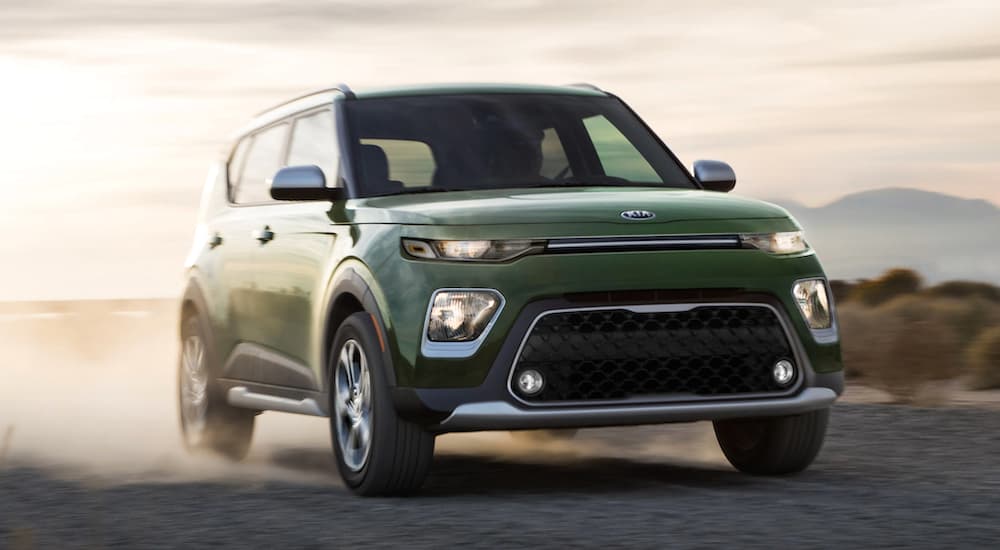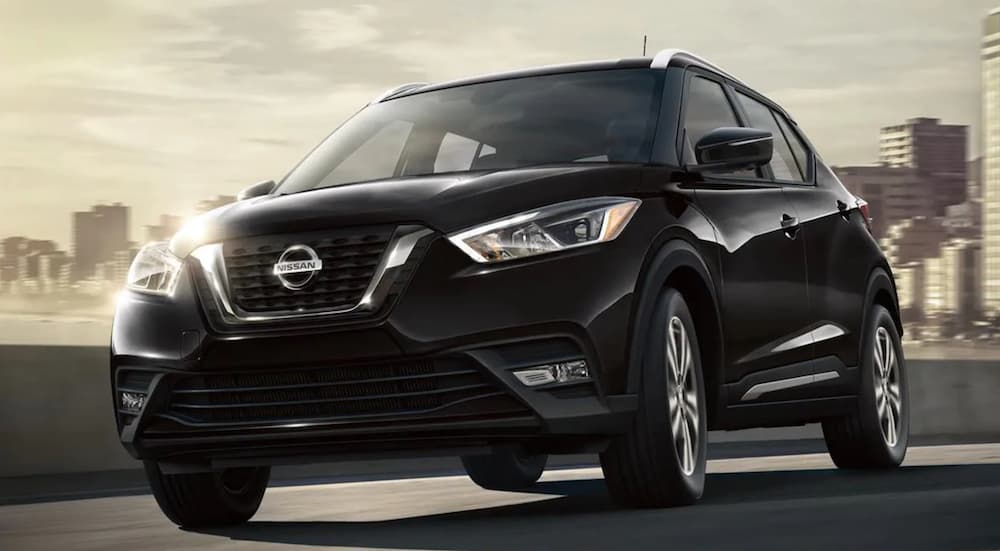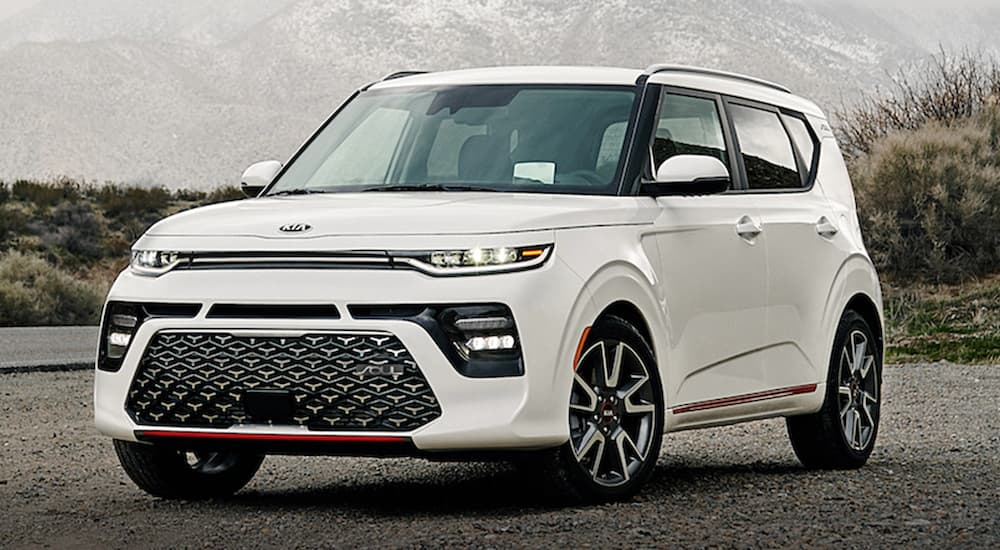The mass appeal of city-friendly subcompact SUVs has allowed this segment to become very competitive in a relatively short timespan. Millions of people live with firm budgets and limited space but still need a vehicle; subcompact SUVs allow them to work within those limits while still attaining the practical spaciousness of the SUV format. To better market themselves to buyers that would like something special from their ride, manufacturers offer these small and inexpensive vehicles with a plethora of customization options to make each of them unique. Pitting two of the best models in the segment against each other, a 2021 Kia Soul vs 2021 Nissan Kicks comparison highlights the emphasis on efficiency, practicality, and personality that is the signature of this class.
The Kia Soul was introduced in 2010 and is now in its third generation. Introduced as a practical, spirited, and low-cost alternative to existing crossovers, the Soul was offered with many special edition packages and powertrain options. The second generation, released in 2014, had a longer wheelbase to improve the ride quality and emphasized a premium musical experience, offering Pandora streaming, Bluetooth connectivity, and six illuminated speakers for a personalized atmosphere. These changes inspired the evolution of the third-generation model, which sports even more ambient lighting, color-coordinated trim inserts, and an available Harman Kardon sound system. The X-Line and GT-Line trims emphasize the Soul’s performance characteristics, and an available Soul EV offers all of the Soul’s spirit in a minimal-carbon-footprint package.
The Kicks is a newer model, introduced in the US in 2018 as a replacement for the uniquely styled Nissan Juke. Its more conventional shape is less alienating than the Juke was, but it draws inspiration from Nissan’s best styling points and keeps pace with the trends of the segment. Nissan doesn’t offer a dozen trim and powertrain combinations as Kia does, but by keeping things simple and focusing on what it does best, Nissan delivers a balanced, high-value product with some of the best fuel efficiency results on the market.
“Powertrain” May Be a Misnomer
In a vehicle class that emphasizes lightweight, high-efficiency designs, engine power comes secondary. The 2021 Nissan Kicks demonstrates this quite clearly. Carrying over the 1.6L I-4 that’s on the 2020 model and paired with a continuously variable transmission (CVT), the Kicks only puts out 122 hp and 114 lb-ft of torque. That’s fine for a Sentra, but with an SUV-style body, it means poor acceleration. As such, its highway passing skills are negligible, but it’s still a capable around-towner, and its 33 MPG combined fuel efficiency rating makes the trade-off worthwhile for environmentally conscious drivers.
Kia isn’t so willing to sell their Soul to the automotive devil and sacrifice all driving thrill for efficiency. Most 2021 models come fitted with a 2.0L engine that can make 147 hp and 132 lb-ft of torque, giving it good acceleration for the segment. For drivers who love cars that are fast and practical, top-trim Turbo models are so named for the 1.6L turbocharged engine they receive. This increases output to 201 hp and 195 lb-ft of torque for some surprisingly snappy performance. While the base models of the 2021 Soul do come with a CVT, a manual transmission is also an option, and the Turbo comes with a seven-speed dual-clutch transmission.
Many drivers don’t want to compromise between fun and efficiency. The Kia Soul EV offers such drivers another way. The 2021 Soul EV is anticipated to deliver the same 201 hp as the turbocharged model with a range of 243 miles on a single charge. The Soul EV offers engaging acceleration with no emissions or low carbon footprint that the 2021 Kicks can’t even come close to replicating.
Eye Candy
Both the 2021 Kia Soul and 2021 Nissan Kicks deliver unique, distinctive styling. Just because they’re affordable, they don’t need to be boring! Both wear bold grilles for an athletic appearance. The Kicks’ narrow headlamps blend into Nissan’s signature strong chrome V, framing the tall black intake. The Soul looks a little leaner with even narrower headlamps and a wide, low grille that calls to mind high-performance sports cars.
Black pillars create floating rooflines on both models. This is more pronounced on the Kicks; the Soul’s wraparound taillights and descending roofline reduce the illusion. Both models also offer two-tone paint jobs with the roof set a different color than the body. From the back, the Soul is undoubtedly the more distinct of the two. Taillights that wrap around the entire top half of the liftgate are unusual but interesting. The Kicks’ plastic bumper, on the other hand, is simply off-putting.
Climbing into and driving these small SUVs doesn’t end the visual experience. While the 2020 Kicks has an admittedly simple interior, the digitized instrument cluster and intuitive if simple infotainment system deliver a modern look. On the other hand, the Soul is the pioneer and reigning champion of the in-car disco party. Soul’s signature interior feature is available backlit speakers that pulse to the music they play – the latest generation offers a Harman Kardon sound system with LED backlights that are visible even during the daytime. Infotainment is delivered through a standard 7″ or optional widescreen 10.25″ touchscreen with navigation and traffic, positioned on an angle for a better view from the driver’s seat. Round it out with body-colored textured inserts on the door panel, and you’ve got an interior that’s a delight just to look at.
Bigger on the Inside
Like subcompact sedans, the subcompact crossover segment uses a short wheelbase, small overhangs, and high ceilings to make them the most maneuverable, easy-to-park cars on the market while still fitting everything you need inside. The Soul and Kicks offer comfortable seating for four adults and ample space for their belongings, successfully achieving this goal of their class.
The Nissan Kicks uses a more conventional body style than the Juke it replaced, giving it more interior volume. In the seating area, this translates to front-seat headroom and legroom that’s at or near the top of the class at 40.7″ and 43.7,” respectively. However, the Kicks does falter with only 33.2″ of rear legroom. Still, 93.9 cu.ft. of overall passenger space is something for the segment to aspire to, and Nissan’s Zero Gravity seats with 14 pressure points for continuous full-body support are some of the best in the business.
Even the Kia Soul lags behind the Kicks for front seat spaciousness, sitting at 39.4″ and 41.1″ of head and legroom, respectively. However, the Soul’s boxy profile allows it to match those numbers in the back – its 39.5″ of rear headroom and 38.8″ of rear legroom are substantial improvements against the Kicks. That adds up to 102.2 cu.ft. of passenger space overall. While the Kicks doesn’t feel cramped, the Soul is simply bigger.
The size advantage carries to the cargo hold too. Although the Kicks has a slight edge with 25.3 cu.ft. behind the second row to the Soul’s 24.2 cu. ft, the practical difference isn’t much. However, the game changes when the second row of seats gets folded for a cargo-centric journey. While the Kicks impresses with 32.3 cu.ft., the Soul blows it out of the water. With seats that fold flatter and open up a huge portion of the interior, the Soul’s cargo hold expands to a whopping 62.1 cu.ft.
Soul and Kicks – Riding and Vibing
The subcompact SUV segment is marketed to folks who want to satisfy a small budget, have a small carbon (and physical) footprint, and still make the most of the fact that they have a car. The Kicks delivers a decent ride with engaging colors and style, along with sufficient space for adventurous use and some of the best non-hybrid efficiency numbers you can find. However, next to the 2021 Kia Soul’s interior mood lighting, expansive back row, and optional turbocharged and all-electric powertrains, even the Kicks comes off feeling a little bland or, dare we say… Soul-less.






